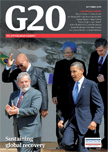

 |
 |
|

How Pittsburgh Can Help Copenhagen on Climate Change
By Frank Loy, former US under secretary of state for global affairs and former chief climate negotiator
To download a low-resolution pdf, click here. (Be patient! It's 7.7 MB.)
Copenhagen needs to resolve five major issues. The G20 summit must produce a meaningful statement of principles that will lead to this resolution.
Expectations are high for the climate conference in Copenhagen in December 2009. They should be. Much is at stake. The science of climate change is unforgiving: every year – every day – that people put more greenhouse gases into the atmosphere means that they are closer to the day that their climate – and way of life – is irreversibly changed. Delay is the enemy of all.
The world expects the United Nations Copenhagen conference to establish an international regime to replace the present Kyoto Protocol one, when the latter expires at the end of 2012. Scepticism abounds over whether the conference will be able to produce such an international agreement. Most of the tough issues that Copenhagen needs to resolve remain unresolved – even after many preliminary meetings.
It is common for decisions in international negotiations to be backloaded – and to delay until the final hours the key decisions and major concessions that need to be made for successful negotiations. No doubt a good deal of backloading is going on here.
But in this instance – negotiations for an agreement of unparalleled complexity, with economic and political consequences larger than the most comprehensive trade agreement – such delay is a risky game. Negotiators at Copenhagen will not be able to come to an agreement without prior political decisions by leaders – their bosses – on key issues.
In September, some 75 days before Copenhagen, the leaders of the G20 will have an opportunity – the last one before Copenhagen – to make Copenhagen a success by taking some of those major policy decisions that need to be made.
That is both the G20’s opportunity and obligation. The G20 is in many ways the ideal forum for this. At the table will be a manageable number of key players. They represent all the different political imperatives, motivations or drivers that shape Copenhagen negotiating strategies.
All the players in climate negotiations are, of course, motivated by a desire to reduce the risks associated with climate change. But for some this is the primary motivation, while for others that is by no means the case. The parties reflect four different policy drivers:
Copenhagen needs to decide on five major issues. The G20 Pittsburgh meeting will only be useful if it produces some meaningful statement of political principles that point the way to their resolution.
First, how much will the industrialised countries cut their greenhouse gas emissions?
Second, what kind of nationally appropriate mitigation actions (namely support for non¬agricultural market access, or NAMA) will rapidly industrialising economies such as China and India take to slow and reverse their emission growth? (At the 2007 Bali climate conference the need for NAMA was agreed to.)
Third, how much financing and how much technical assistance will industrialised countries offer developing countries to help transfer the new technologies for low carbon development?
Fourth, what role will reducing emissions from deforestation and degradation play in the future framework? Deforestation contributes almost 20 per cent of greenhouse gas emissions.
Fifth, how, and how much, will industrialised countries assist developing countries in adapting to rising seas and other consequences of climate change that will occur, regardless of all future steps, because of past emissions?
The leaders of the G20 can contribute to a successful Copenhagen conference by adopting a few principles, or instructions to negotiators. These might include the following:
First, without losing focus on the absolute need to deal with the central issue – climate change – the negotiations at Copenhagen need to be broad enough to address the national interests of all participants, most particularly, the development and adaptation needs of developing countries. While it is politically out of the question to ‘compensate’ the members of the Organization of the Petroleum-Exporting Countries and other suppliers for the loss of markets as demand for oil slows, it should be possible to discuss arrangements between producer countries and consumer countries that recognise that petroleum remains a critical part of the world’s energy picture for the near and mid term, even as it becomes marginal in the long term.
Second, the negotiators need to set tough but realistic emission reduction targets for industrialised countries. Some of these will be aspirational while others will reflect real commitments. In setting the latter, they need to avoid target levels that are politically unrealistic and therefore will not be met.
Third, G20 leaders need to describe a range for the financial contributions from the industrialised countries that should be in the final agreement, expressed either in absolute terms or in the form of a formula. Parliaments and the publics of all participants need to understand early on that the amount will be considerably larger than most industrialised countries have contemplated, and considerably smaller than developing countries have demanded.
Fourth, G20 leaders must clarify what is expected from the rapidly industrialising developing countries. Their contributions may take different forms, but generally will be commitments to take specific actions to reduce emissions, in contrast to commitments to reduce emissions by a fixed amount. Their obligations need, however, to exhibit several characteristics: Commitments need to be legally binding, and the targets need to be ambitious, given the national circumstances of the country. It must be possible to monitor, measure and verify the reduction results of the actions. And commitments should be part of a larger national plan that envisions a flattening of the growth curve of annual increases in the country’s emissions at a specific future date, followed by a reduction of emissions in absolute terms.
This is a tall order for the G20. But it is not an unreasonable one. The health of the planet requires that it be met.
|
This Information System is provided by the University of Toronto Library |
All contents copyright © 2023. University of Toronto unless otherwise stated. All rights reserved.